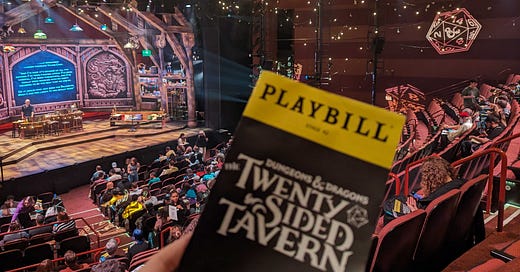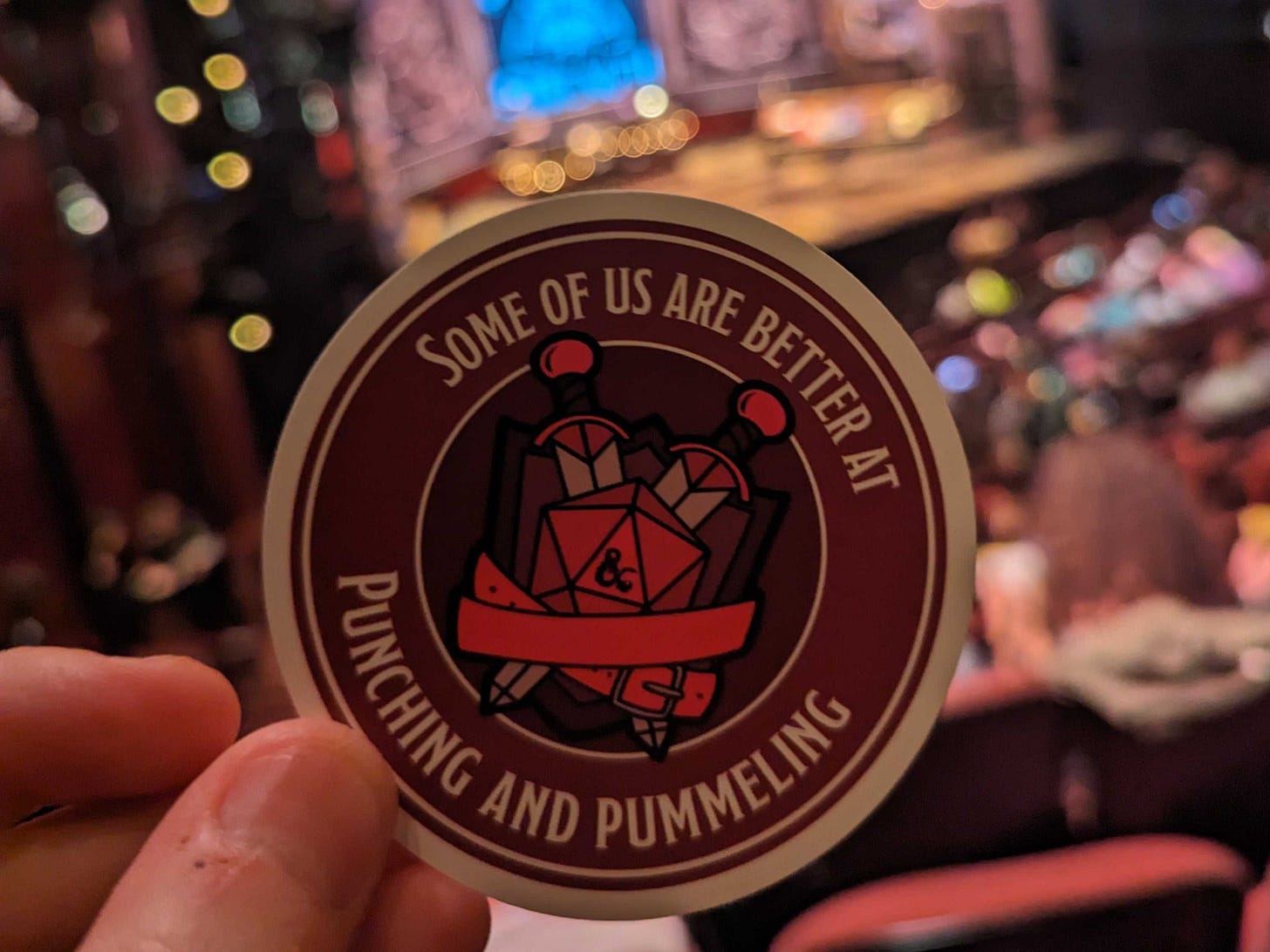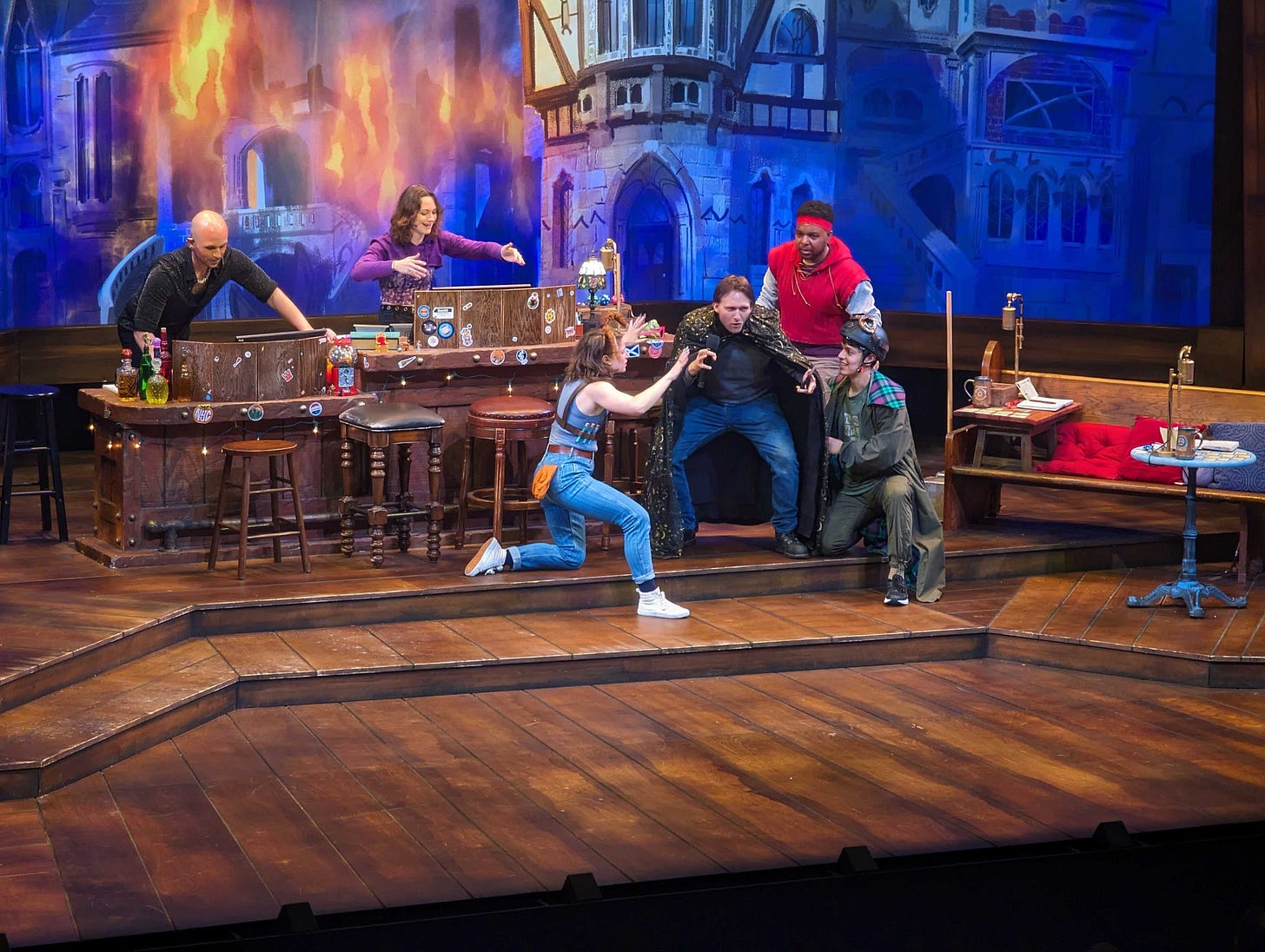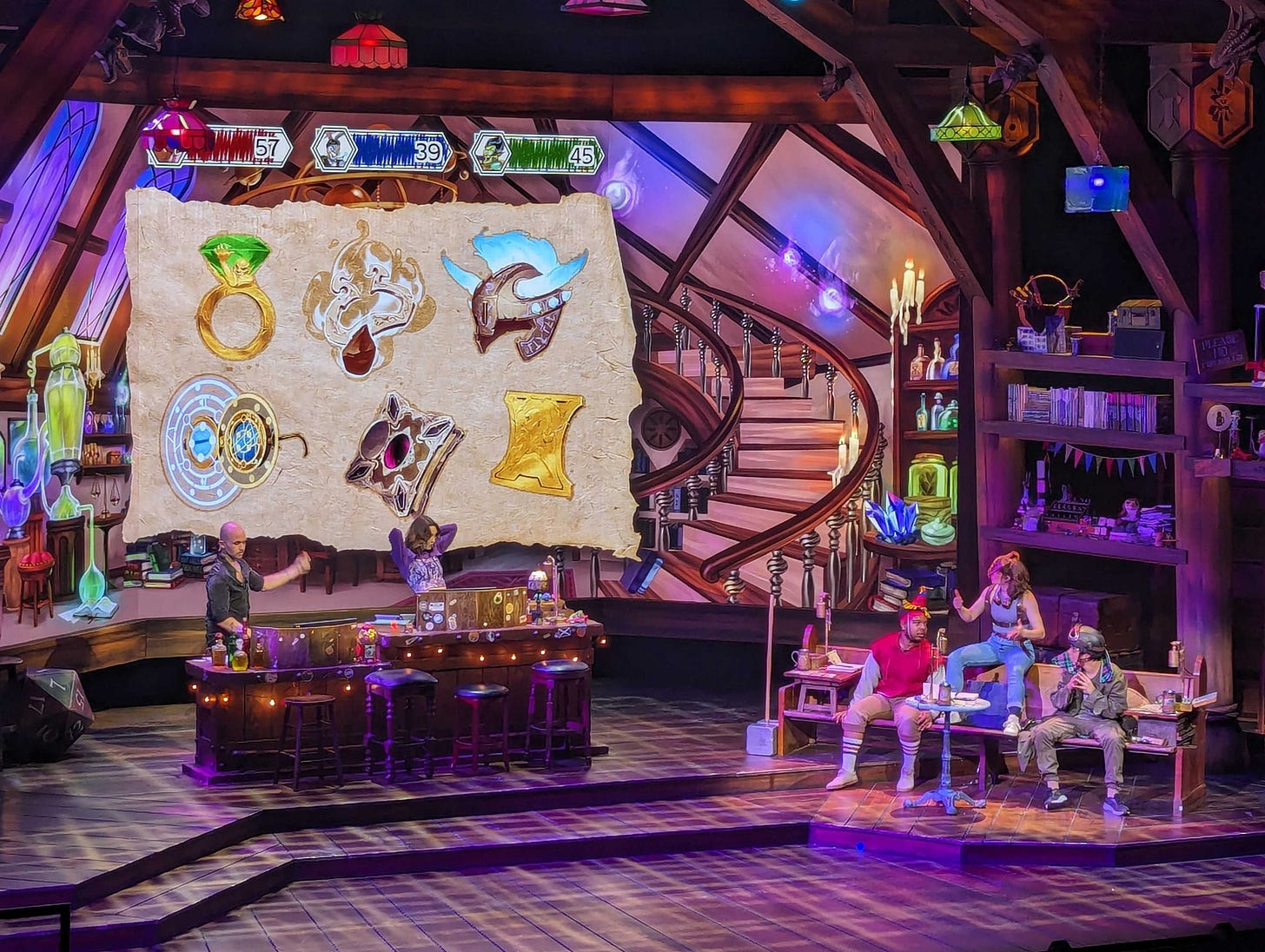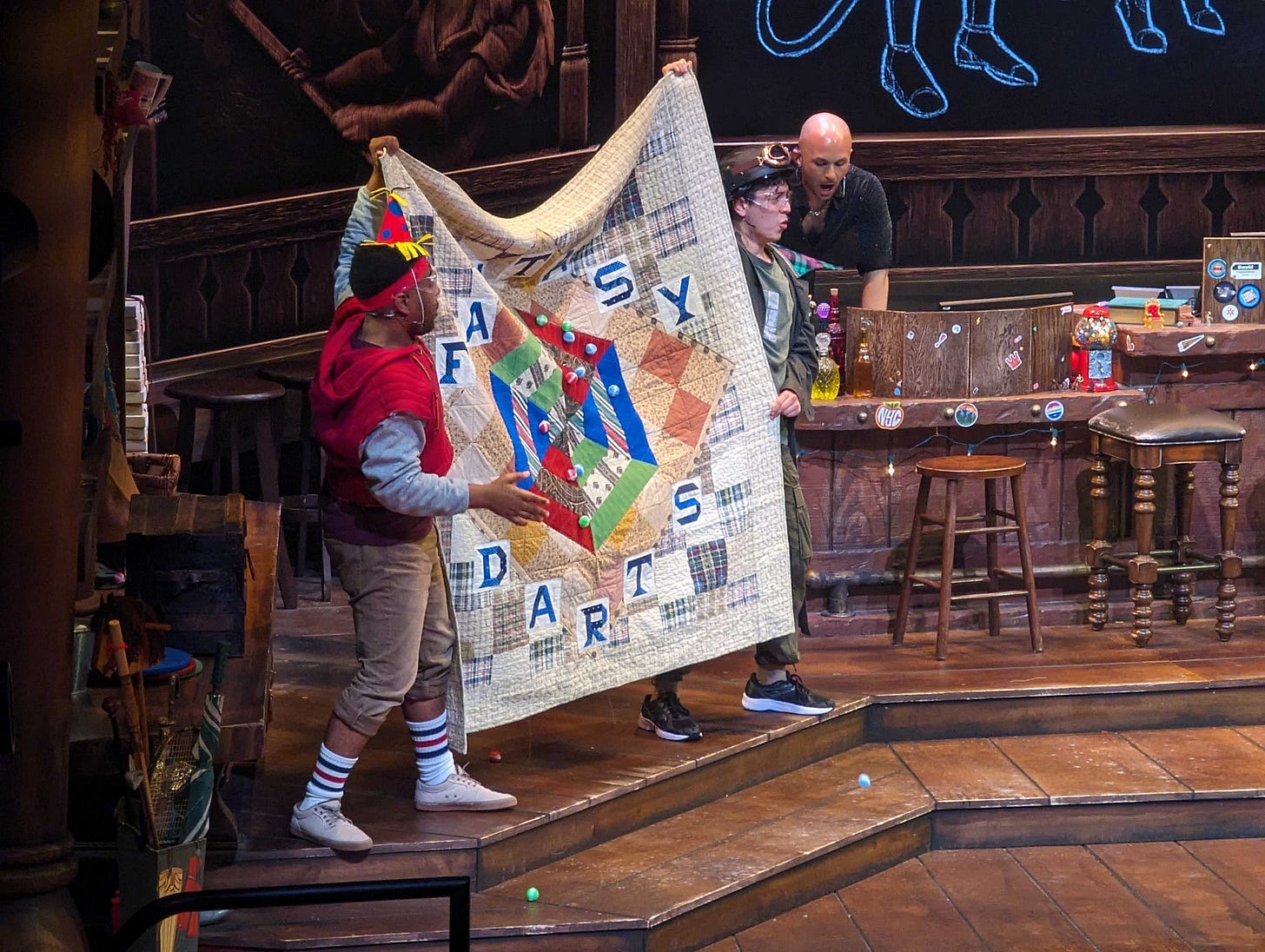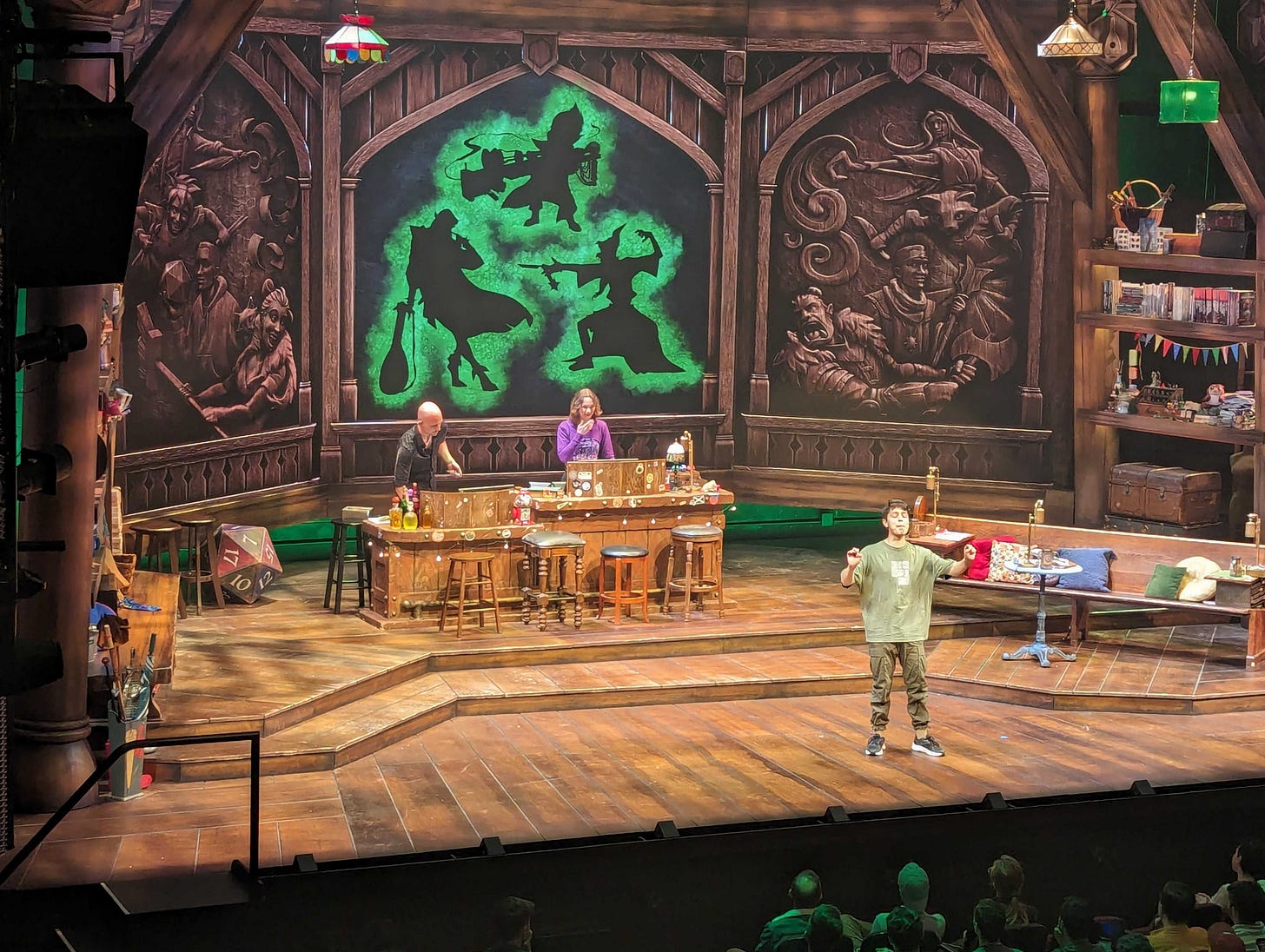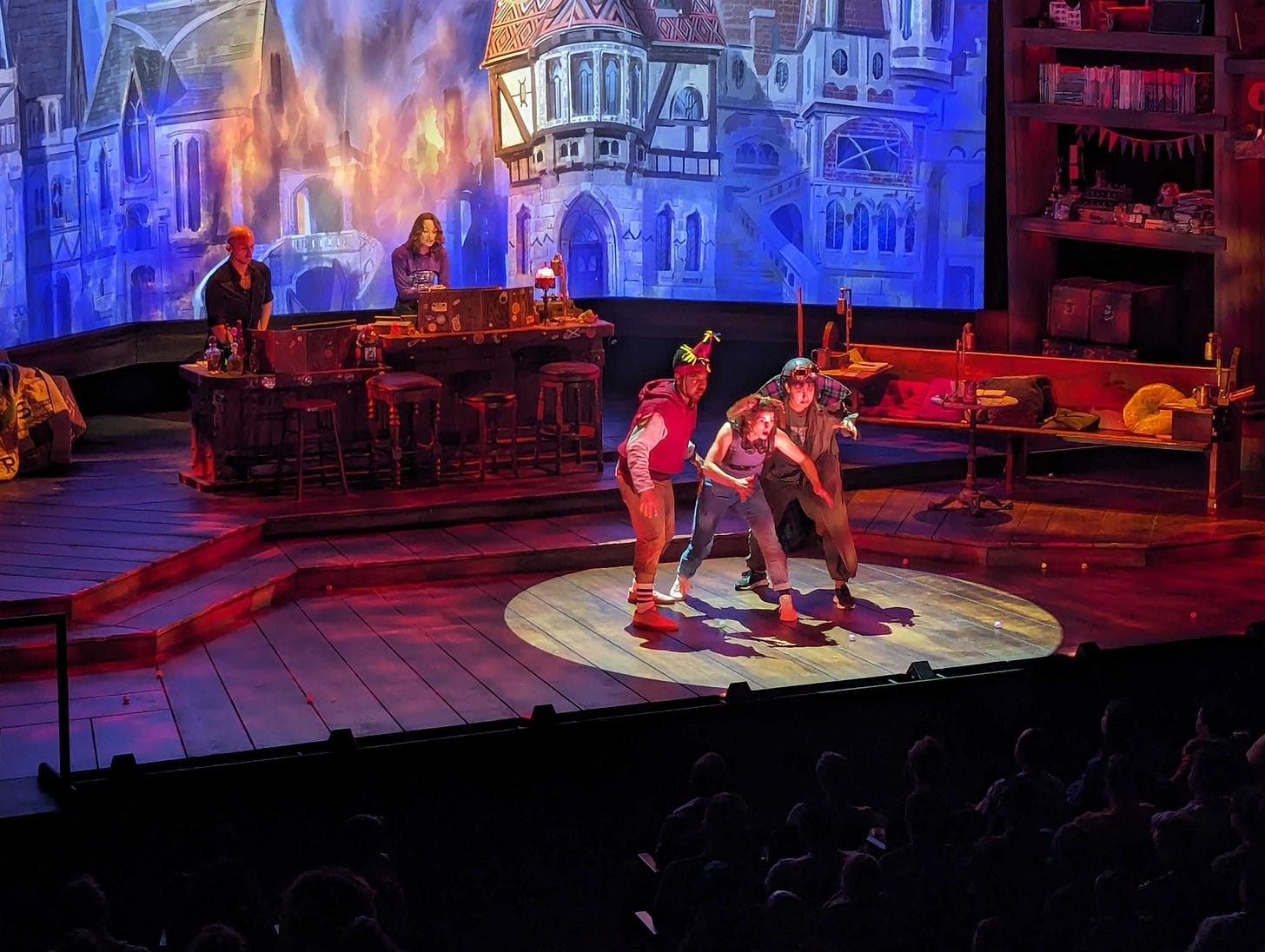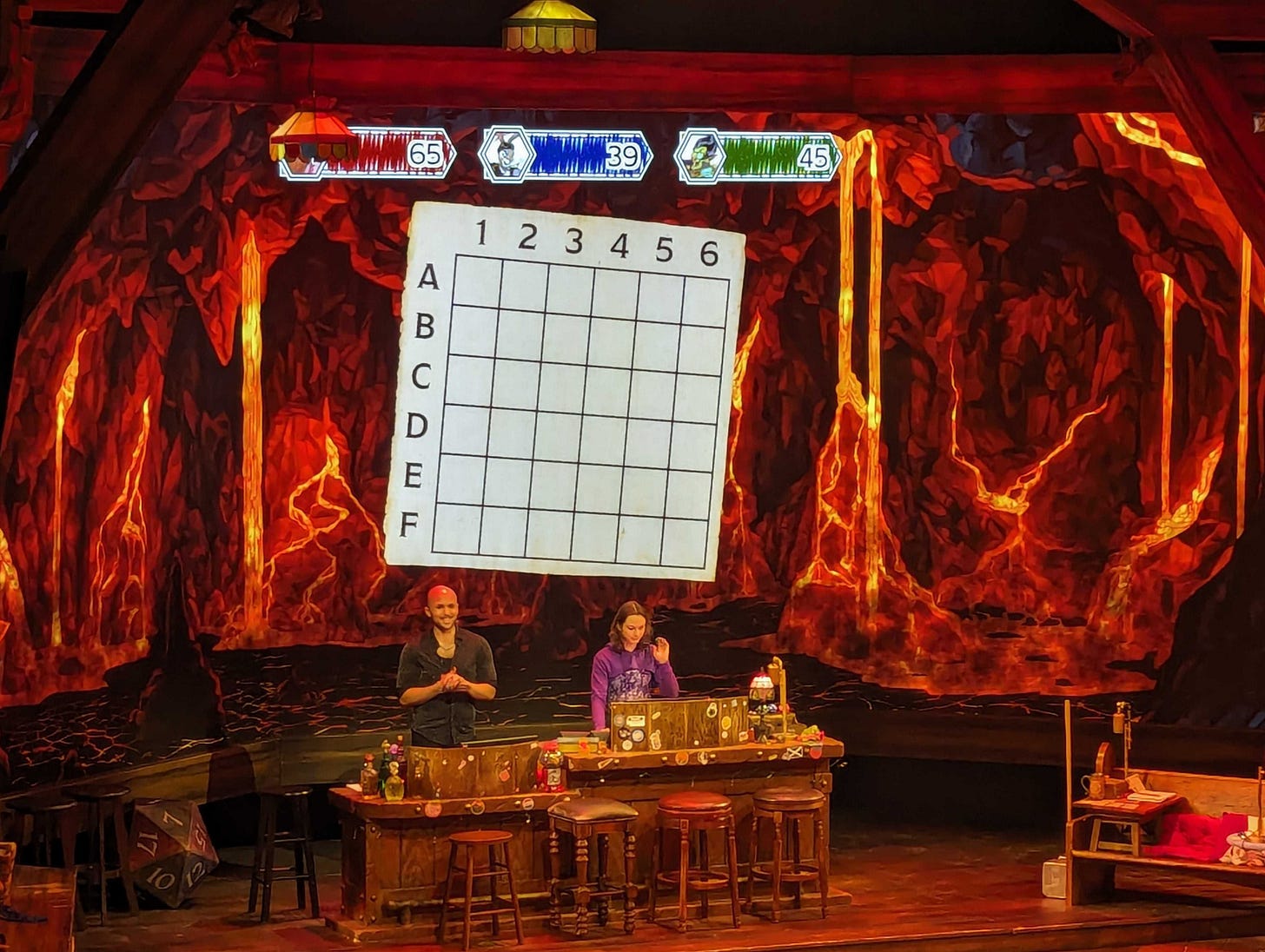Notes From The Twenty Sided Tavern
Potential for a fun night, as long as your expectations are managed
Last week, I went to check out The Twenty Sided Tavern, a new off-Broadway show that promises an interactive game of Dungeons & Dragons, where the audience has control of the story. As the website explains: “you can tell the performers what to do, where to go, and what dangers they’ll face.”
The design decisions and trade-offs that were necessary to deliver on that promise transformed a fascinating concept into a production with a very different target market in mind. Portions of the audience clearly loved the experience, so this article is an attempt to explore what that intended audience looks like.
What is Twenty Sided Tavern, and How Does it Work?
Upon arriving at the theater, attendees are handed their Playbill, and quickly discover that a sticker slipped into the program sorts them as supporters of one of three Adventurers for the show: Red for the “Warrior”, Blue for the “Mage”, and Green for the “Trickster”.
By logging into the Gamiotics website on their phone (the platform that powers much of the experience) theatergoers can register their affiliation for the evening, allowing them to help make decisions for their chosen Adventurer for the evening. In part because the show relies so heavily on phone usage, audience members are encouraged to use their phones and take pictures/videos during the show, which is why I feel so comfortable sharing a post about an off-Broadway show that relies so heavily on visuals.
The first (and most impactful) decision of the evening is selecting which of three archetypes their Adventurer will be playing for the evening.

As the evening progresses, the audience will be presented with a number of choices: from narrative choices (“what should this NPC’s name be?”) to combat choices (“which attack should the character attempt for this combat round?”), along with a few puzzles and mini-games to spice up the action.
The goal of the show is to guide audience members through a full adventure in this fashion, over the course of a little over two hours. And that’s where it becomes harder to identify the intended audience for the show. Because the interactive elements are prioritized over almost everything else, leading to a somewhat rushed story that doesn’t deliver meaningful choices enough to feel like a D&D game, and doesn’t give enough freedom to the actors to fully work as a heavily themed improv comedy show.
In the end, I suspect The Twenty Sided Tavern works best if approached as a physical comedy that uses elements of improv comedy and tabletop design to keep the audience engaged throughout the show. However, attendees who go in expecting a full improv or tabletop experience are likely to leave disappointed.
Fair warning: while the next sections do still talk about the show in generalities, much of what gets discussed could be considered spoilers. So stop here unless you’re comfortable with knowing the structure of the show.
Twenty Sided Tavern’s Greatest Strength: Meet Audience Members Where They Are
The strongest moment of The Twenty Sided Tavern comes slightly after its halfway point, when the Dungeon Master realizes they have too many NPC roles to play, and asks the audience to help. A poll pops up on audience members’ screens, asking if they’d be interested in taking over a role.
The Gamiotics app uses those responses to select an audience member who is cast as one of the NPCs. The phone provides the lucky guest a script for the scene, and after performing their lines they are asked to act out a daring escape on stage with the Adventurers, running in place before dodging, weaving and even dancing their way to freedom.
The audience member selected for the night absolutely knocked the performance out of the park: and that was in part because The Twenty Sided Tavern set him up for success. Attendees who didn’t want to get involved could opt out, and enthusiastic hand-raisers got the chance to be celebrated with clear instructions on what to do. And the same was true for the show’s other interactive moments: with one notable exception, audience members had to opt-in to name characters or participate in on-stage minigames and dice rolls.
And making sure the show’s audience participants are engaging with the show enthusiastically is a large part of what made things work so well for the show. Potential attendees: you can rest easy with the assurance that this particular performance won’t ask anything of you you’re not prepared to do.
Twenty Sided Tavern Doesn’t Leave Much Space for Story
For a show with a run-time of slightly over two hours, The Twenty Sided Tavern chose an aggressive amount of narrative to get through. Our night’s adventure was framed as Carriers of Chaos, opening up the possibility that additional narrative modules might be introduced as the show continues.
After an introductory encounter in a tavern that introduces the show’s core mechanics and an encounter with three mobs to introduce how combat works, the three characters learn of their mission for the show: collecting a series of six MacGuffins.
Because this structure left so much ground to cover, Dungeons and Dragons fans hoping for a rich narrative will likely be left wanting. Some of this is an artifact (pun intended) of Carriers of Chaos’ MacGuffin collecting structure, but a lot of it boils down to the limitations of live theater as a whole.
Many “actual play” tabletop shows rely on serial episodes to give space for depth of story, and even then individual episodes often stretch on for hours. And while the space also allows for one-shot adventures, they rarely have to contend with character creation and mechanical onboarding into the performance.
Twenty Sided Tavern Rarely Replicates the Feeling of Playing a Game of D&D
Ultimately, tabletop games revolve around making choices that have narrative weight. And while The Twenty Sided Tavern is absolutely filled with opportunities to influence what happens on stage, practically none of those moments end up mattering, much.
Audience members are asked to assume some of the DM’s roles by naming each of the game’s NPCs, and the Adventurers do a good job of riffing off those names to add some wink-and-a-nod comedy to the show…but in the end, it’s just a name.
The audience is empowered to make a few major choices during the show…but often those are binary choices that determine which of two locations you visit, or which of two attacks to use on an enemy. The closest the show came to creating the illusion of agency was in asking whether the Adventurers should try and persuade an NPC to help, or threaten them into lending aid - a decision that was still managed by the roll of a d20.
There were a handful of opportunities for audience members to play minigames to influence events (either by succeeding at multi-tap challenges on the phone or by pulling up select audience members to play a game of Fantasy Darts on stage) along with a handful of “memory checks” to ensure the audience was paying attention, but these ended up feeling like slightly more participatory methods of determining the success or failure of a task than invitations to meaningfully engage with the game.
Ultimately, the vast majority of these opportunities ended up feeling empty, like playing a game of D&D with a dungeon master who insists on railroading players down a set path.
Twenty Sided Tavern Doesn’t Quite Feel Like an Improv Show
It’s entirely too tempting to compare The Twenty Sided Tavern to improv shows. The show opens with the audience choosing characters for the show’s three Adventurers, and there are regular opportunities for those audience members to control the actions taken on stage.
That’s an unfair comparison to make, however, since the choices are so constrained. Character selection is left up to the audience…but is limited to the three pre-selected choices. Audience-generated names open the door for pithy one-liners (our show’s obsession with naming everyone variants of “David” likely led to a more musically-themed show than otherwise might have occurred), but the show’s pace didn’t give enough space for the cast to truly go off the rails beyond the periodic call-back.
Ultimately, the cast’s ability to dive deep into improv was hamstrung by the show’s own narrative structure. They were able to play within the marginalia of the narrative enough to prove that the show was (I assume) largely unscripted, but weren’t given the space or freedom to use that flexibility to really capture the magic of improv.
Twenty Sided Tavern IS A Show That Revels in Physical Comedy
There are many things The Twenty Sided Tavern tried to do: it’s delivering a full adventure…but in trying to pack in so many narrative beats, the story ends up somewhat lacking. It’s drawing upon tabletop game mechanics…but the relatively empty choices don’t even create the illusion of agency. And while the show’s structure should lend itself to improv comedy, the show’s narrative constraints restrict the freedom to explore beyond the occasional one-liner.
But if there’s one thing The Twenty Sided Tavern excels in without reservations, it’s physical comedy. The show’s cast takes an almost Vaudevillian approach to the physicality of the show. Practically every scene saw dramatic entries and exits from the Adventurers that showcased their character archetypes for the night, with over-the-top reactions to practically every moment of the show. At one point, our Warrior showcased his strength by doing squats with the Mage sitting on top of his shoulders.
And it’s that borderline slapstick comedy that I found to be the heart of the performances, as the cast embodied their archetypal characters in the most literal sense.
One Final Compliment: A Particularly Interesting (and Ambitious) Puzzle
The presence of Gamiotics was heavy-handed enough in the show that it almost felt like an advertisement for the platform. And their strongest sales pitch came in the form of the final “puzzle” of the show, which involved identifying the correct coordinate on a grid.
The puzzle was relatively simple: three clues were sent out to the audiences’ phones, narrowing down which cell to select. However, those three clues were split out across audience members, with participants “following” the Warrior getting the first clue, those “following” the Mage getting the second clue, and those “following” the Trickster getting the final clue.
This asynchronous information required audience members to actually talk to their neighbors and share information. The puzzle wasn’t perfect - vague wording meant there were technically two potential answers depending on how you interpret the final clue - but the collective nature of the puzzle meant that even after I submitted the wrong answer, I was able to make sure the people sitting near me put in the correct answer.
Gamiotics can enable collective voting for events, and even expanded that functionality out to enable in-theater quick time events. Which is fine, and those are interesting features to have at your disposal for an “interactive” show. But I’m much more interested in its ability to select an audience member who’s eager to participate in the show, and feed out a script for them to follow upon selection. And I’m excited to see functionality focused around sending different information to audience members that encourage them to strike up a conversation with their neighbors to collectively solve a challenge.

